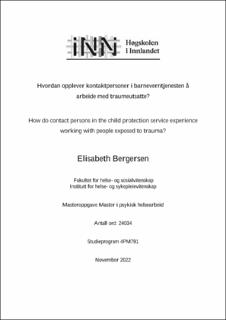Hvordan opplever kontaktpersoner i barneverntjenesten å arbeide med traumeutsatte?
Master thesis
Permanent lenke
https://hdl.handle.net/11250/3064671Utgivelsesdato
2022Metadata
Vis full innførselSammendrag
Bakgrunn: Kommunal barneverntjeneste har et samfunnsoppdrag i å ivareta de barna i samfunnet som lever under forhold som kan skade deres helse og utvikling, og sikre at de får nødvendig hjelp, omsorg og beskyttelse til rett tid. Det er i stor grad kontaktperson i barneverntjenesten som skal kartlegge og undersøke om barns omsorgssituasjon er god nok. En stor andel av barna som kommer inn i barneverntjenesten sitt system har egne tidligere traumer, lever under traumatiske omsorgsbetingelser, eller har foreldre som er traumatisert.1.1.2023 trer ny lov om barneverntjenester i kraft som ledd av en oppvekstreform i Norge. Ansvaret for barneverntjenesten tillegges kommunene, kvaliteten i barneverntjenesten skal styrkes, og søkelys på hvilke barn som barneverntjenesten skal jobbe med skal kvalitetssikres. Det er kun de saker hvor det er vesentlig bekymring for barnets omsorgssituasjon som skal meldes til barneverntjenesten. I fagfeltet blir dette omtalt som «kjernebarnevern». Dette vil blant annet medføre et større antall av alvorlige saker som skal utredes og et større antall traumeutsatte barn og voksne.
Problemstilling i studien: Hvordan opplever kontaktpersoner i barneverntjenesten å arbeide med traumeutsatte?
Metode: For å få belyst problemstillingen anvendte studien kvalitativ metode med induktiv tilnærming. Syv informanter som jobbet som kontaktperson i en kommunal barneverntjeneste på Romerike, ble intervjuet. Under intervjuene ble det benyttet semistrukturert intervjuguide. Studiens datamateriale ble analysert med systematisk tekstkondensering som strategi, en strategi utviklet av Kirsti Malterud.
Resultater: I studien fremkom det at arbeid med traumeutsatte i en kommunal barneverntjeneste oppleves både fysisk og psykisk krevende, personlig belastende og at bekymring for egen helse til tider er stor. De organisatoriske rammene, det psykososiale arbeidsmiljø, og samfunnet er faktorer som påvirker opplevelsen av arbeidet. Videre fremkom det i studien at på tross av dette gir arbeidet mening, mestringsfølelse og en følelse av egenverdi.
Konklusjon: Funnene i studien kan tyde på at arbeid med traumeutsatte i en barneverntjeneste er en givende og krevende jobb på samme tid. Det fremstår et behov for økt forståelse for hvordan kontaktperson påvirkes av å jobbe med traumeutsatte, hvilke forhold som bidrar til å øke og redusere kontaktperson sin helse, og aktiv handling og vilje til å sette inn forebyggende tiltak for å forhindre eller minske fare for helserisiko.
Nøkkelord: Traume, traumeutsatte, reaksjoner, sekundærtraumatisering, relasjon og selvet. Background:The municipal child welfare service has a social mission to take care of the children in society who live in conditions that may harm their health and development, and secure that they receive the necessary help, care and protection at the right time. It is largely the contact person in the child welfare service who will map and investigate whether the children's care situation is good enough. A large proportion of the children who enter the child welfare service's system have their own previous traumas, live in trauma, or have parents who are traumatized.1.1.2023, a new law on child welfare services enters as part of an upbringing reform in Norway. Responsibility for the child welfare service is assigned to the municipalities, the quality of the child welfare service shall be strengthened, and the focus on which children the child welfare service should work with must be quality assured. Only those cases where there is significant concern about the child's care situation will be reported to the child welfare service. This will, among other things, support a number of serious cases to be investigated and a larger number of trauma-prone children and adults.
Research question in the study: How do contact persons in the child protection service experience working with people exposed to trauma?
Method: In order to shed light on the issue of the study, the study used qualitative methods with an inductive approach. Seven informants who worked as a contact person in a municipal child welfare service in Romerike were interviewed. Semi-structured interview guides were used during the interviews. The study's data material was analysed using systematic text condensation as a strategy developed by Kirsti Malterud.
Findings: The study showed that working with trauma victims in a municipal child welfare service is perceived as both physically and mentally demanding, personally stressful, and that concern for one's own health was at times great. The organizational framework, as well as the psychosocial working environment, were factors that influenced the experience of the work.Furthermore, the study showed that despite this, the work gives meaning, a sense of mastery and a sense of self-worth.
Conclusion: The findings of the study may indicate that working with trauma victims in a child welfare service is a rewarding and demanding job at the same time. There appears a need for increased focus on how the contact person is affected by working with trauma victims, which conditions contribute to increasing and reducing the contact person's health, and active action and willingness to implement preventive measures to prevent or reduce the risk of health risks.
Keywords: Trauma, trauma exposed, reactions, secondary trauma, relationship, a persons self.
